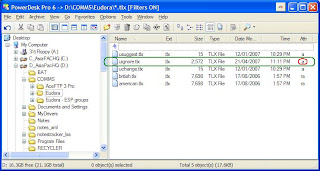Local Aussie IT commentator Stan Beer has been trying out some Linux alternatives to Windows and on 12
th April wrote
Kubuntu looks nice but come on fellas, wireless input followed the next day by
Ubuntu fanboys on Linux Today arise for wireless input rantI have just added my own views as a comment to Stan's blog, and thought that it would be useful to post them here in my own blog as well ...
----------------------To a greater or lesser extent all software "sucks" (to put it in charmless U.S. vernacular). It's not at all surprising that you had issues with you wireless mouse and keyboard.
The advantage of the various versions of Windows is that they have a HUGE installed base, leading to an abundance of device drivers and other third-party software products big and small. Due to the relatively limited number of versions, there's an excellent chance that you can easily enough find a solution to just about any problem you have. But even with something as well understood as Windows, you can still have unresolvable problems with device support (especially if you purchase "
el cheapo" products with faulty or feature-incomplete drivers, and you certainly can't blame Microsoft for that).
I've now received a copy of Vista Business as part of the "But now with Windows
XP and get a free copy of Windows Vista" coupon for the new high-end desktop system I purchased just before Christmas last year. However, I'm going to stick with Windows
XP Pro for quite a while, because (a) it's extremely stable and already does everything I want, and (b) due to the nature of my business, I have a very large number of software products installed that are not yet Vista-enabled, so I don't dare or care to switch across and undergo the agony that's sure to follow. So my copy of Vista will be sitting on the shelf for quite a few months yet.
There are so many flavors of Linux (and UNIX) that the installed base of any one of them is relatively small (compared wit Windows), and so the volume of device drivers and other software is somewhat restricted. While at IBM, I was involved with the first release of
AIX (IBM's implementation of UNIX) back in the mid-1980s. IBM did an enormous amount of work before release
AIX Version 1.0, particularly in eliminating what it saw as a large number of security holes in UNIX. They also developed a more menu-driven approach to using the system, which some UNIX purists did not like at all because they were accustomed to using the command line interface of whichever UNIX shell they preferred and considered
AIX's menu structure as being too intrusive. You just can't please everybody!
With Linux, there are now so many distributions that it's a nightmare trying to keep up with what's available, even within a single variant (such as
Ubuntu, or whatever). So the very diversity and openness of Linux brings its own problems.
I've been using Microsoft's Virtual PC (
VPC) over the past few years to install and test a range of Linux
distros,with wildly varying degrees of success.
VPC emulates a fairly basic hardware configuration, and maybe that's a problem in itself, but I suspect not. Roughly half of the
distros installed okay. With the other half, there was a common thread: the display device drivers misbehaved. One category was that the initial installation screen was totally unreadable (typically having bands of colored lines with no discernible text), so that the installation had to be aborted at the very start. The other category was when the installation went okay, then when I rebooted the same sort of garbled display occurred.
Which
distro succeeded or failed was quite unpredictable. For example, I purchased a license for
Linspire 5.0 (which is the son of "
Lindows", this original product name having to be dropped following intense legal pressure from Microsoft).
Linspire installs and runs on Virtual PC without any problems. From the same stable comes a free variant called
Freespire, but disappointingly it spews out the same sort of unintelligible initial install screen as some others. (So it seems that the underpinnings of
Freespire are somehow different from those of
Linspire.)

Apparently the fact that
Linspire contains a raft of proprietary device drivers is enough to upset some Linux purists. But I'm trying to be nothing more than pragmatic here: if it works well out of the box (and has good commercial support if you need it), that's fine with an IT veteran like myself. And it's probably quite good enough for your average end user, who certainly won't have the least desire to get involved with the cryptic, arcane and obscure side of Linux.
If two Linux variants from the same stable act differently, then it's not at all surprising that those from different stables yield such divergent outcomes. Here's a series of relevant articles (by one "
Briard") on this theme "Linux Desktop – Is it an Option for Normal Users?" that are well worth a read: PART 1 is at
http://www.techsupportalert.com/review-linux-for-windows-users.htm and PART 2 is at
http://www.techsupportalert.com/review-linux-for-windows-users-part-2.htm and PART 3 is at
http://www.techsupportalert.com/review-linux-for-windows-users-part-3.htm (they are in Gizmo's Tech Support Alert, in itself an extremely useful source of valuable information ...
http://www.techsupportalert.com/ ).



















